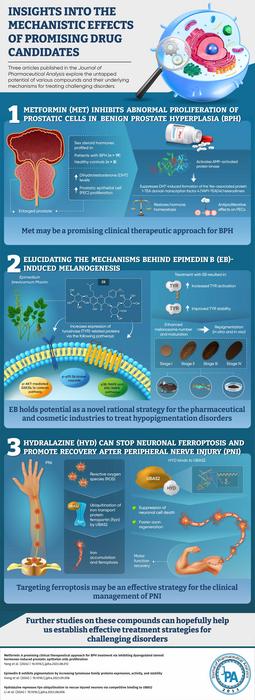
Journal of Pharmaceutical Analysis studies find promising drug candidates
Understanding the underlying mechanisms of normal and pathological cellular processes is an essential during the process of drug discovery for identifying new therapeutic drug candidates. Fortunately, modern analytical techniques, coupled with well-established in vitro and in vivo experimental methodologies, has greatly accelerated progress on this front. The latest issue of JPA features three articles in which candidate compounds for treating complex disorders were successfully identified, alongside their detailed mechanisms of action.

Credit: Journal of Pharmaceutical Analysis
Understanding the underlying mechanisms of normal and pathological cellular processes is an essential during the process of drug discovery for identifying new therapeutic drug candidates. Fortunately, modern analytical techniques, coupled with well-established in vitro and in vivo experimental methodologies, has greatly accelerated progress on this front. The latest issue of JPA features three articles in which candidate compounds for treating complex disorders were successfully identified, alongside their detailed mechanisms of action.
The first study investigated the use of metformin (Met), a drug used to manage type II diabetes, for treating benign prostate hyperplasia (BPH). The article was published in Volume 14, Issue 1 of the journal in January 2024. The researchers first sought to shed light on how and which dysregulated sex steroid hormone-related pathways shape the pathological characteristics of BPH, and whether Met can restore these pathways.
Through retrospective analysis of data from BPH patients and clinical assessment of serum and tissue samples, the researchers identified dihydrotestosterone (DHT) as a major contributor to BPH among dysregulated sex hormones. They found that DHT increased prostatic epithelial cell proliferation via the upregulation of androgen receptors and the subsequent formation of YAP1–TEAD4 heterodimers. Interestingly, in vivo experiments revealed that treatment with Met restored normal sex hormone homeostasis and exerted antiproliferative effects on DHT-affected cells. “Our study provided strong evidence that Met might be a promising clinical therapeutic approach for the treatment of BPH,” remark corresponding authors Prof. Qian Lu and Prof. Xiaoxing Yin.
In the second study, scientists explored the role of epimedin B (EB), the main flavonoid in the Chinese herb Epimedium brevicornum Maxim. in melanogenesis. This work builds upon prior research where researchers found that EB strongly induced melanogenesis and activated the tyrosinase family of proteins (TYRs). This time, through comprehensive experiments on human and animal cells in vitro and various animal models in vivo, they shed light on the molecular mechanisms by which EB modulated the activity, expression, and stability of TYRs. They found that EB increased the number of melanosomes and promoted their maturation, ameliorating depigmentation and bolstering repigmentation. “Our data reveals that EB can stimulate the pigmentation function of TYRs, which might provide a novel rational strategy for hypopigmentation treatment in the pharmaceutical and cosmetic industries,” comments corresponding authors Dr. Yiming Li and Prof. Huali Wu.
Finally, in the third study, researchers investigated the molecular mechanisms of ferroptosis, a type of programmed cell death, and how it related to nerve regeneration after peripheral nerve injury (PNI). First, they found that oxidative stress at the injury site not only triggered apoptosis in surrounding neurons, but also induced ferroptosis in neighbouring neurons. This occurred through an increase in intracellular iron, which in turn, happened through the degradation of iron export protein ferroportin driven by the protein UBA52. Using the Drug Signatures Database (DSigDB), the researchers then identified hydralazine (HYD), a potent arterial vasodilator, as a potential candidate to disrupt UBA52. In vivo experiments demonstrated that early administration of HYD after PNI led to faster axon regeneration and recovery of motor function, partially through the suppression of ferroptosis. “The potential clinical implementation of HYD may lead to a reduction in the prevalence of individuals with mild symptoms of nerve damage, consequently mitigating the societal burden,” conclude corresponding authors Dr. Bing Xia, Prof. Zhuojing Luo, and Dr. Jinghui Huang, excited about their findings.
Going ahead, it is expected that further studies will hopefully cement our understanding of the complex interplay between cellular processes, disease states, and drug candidates, ultimately leading us to new targeted and effective therapies.
***
Reference
Authors:
- Tingting Yanga, Jiayu Yuana, Yuting Penga, Jiale Panga, Zhen Qiua, Shangxiu Chena,b, Yuhan Huanga,c, Zhenzhou Jiangd, Yilin Fane, Junjie Liuf, Tao Wangc, Xueyan Zhoua, Sitong Qiana, Jinfang Songa,g, Yi Xub, Qian Lua, Xiaoxing Yina
- Chen Hongh, Yifan Zhangh, Lili Yangi, Haoyang Xuj, Kang Chengk, Zhi Lvk, Kaixian Chenh, Yiming Lih, Huali Wuh
- Shengyou LiL, Xue GaoL, Yi ZhengL, Yujie YangL, Jianbo GaoL, Dan GengL, Lingli GuoL, Teng MaL, Yiming HaoL, Bin WeiL, Liangliang HuangL, Yitao WeiL, Bing XiaL, Zhuojing LuoL, Jinghui HuangL
Affiliations:
aJiangsu Key Laboratory of New Drug Research and Clinical Pharmacy, Xuzhou Medical University
bDepartment of Pharmacy, Affiliated Lianyungang Hospital of Xuzhou Medical University
cDepartment of Pharmacy, The Affiliated Hospital of Xuzhou Medical University
dNew Drug Screening Center, Jiangsu Center for Pharmacodynamics Research and Evaluation, China Pharmaceutical University
eSchool of Life Sciences, University of Essex
fDepartment of Urology, The Affiliated Hospital of Xuzhou Medical University
gDepartment of Pharmacy, Affiliated Hospital of Jiangnan University
hDepartment of TCM Chemistry, School of Pharmacy, Shanghai University of Traditional Chinese Medicine
iDepartment of Dermatology, Shuguang Hospital Affiliated to Shanghai University of Traditional Chinese Medicine
jInternational Education College, Shanghai University of Traditional Chinese Medicine
kShanghai Inoherb Cosmetics Co., Ltd., Shanghai
LDepartment of Orthopedics, Xijing Hospital, Fourth Military Medical University
DOI:
- https://doi.org/10.1016/j.jpha.2023.08.012
- https://doi.org/10.1016/j.jpha.2023.09.006
- https://doi.org/10.1016/j.jpha.2023.08.006
Journal
Journal of Pharmaceutical Analysis
DOI
10.1016/j.jpha.2023.08.012
Method of Research
Experimental study
Subject of Research
Animals
Article Title
Metformin: A promising clinical therapeutical approach for BPH treatment via inhibiting dysregulated steroid hormones-induced prostatic epithelial cells proliferation
Article Publication Date
1-Jan-2024
COI Statement
The authors declare that there are no conflicts of interest